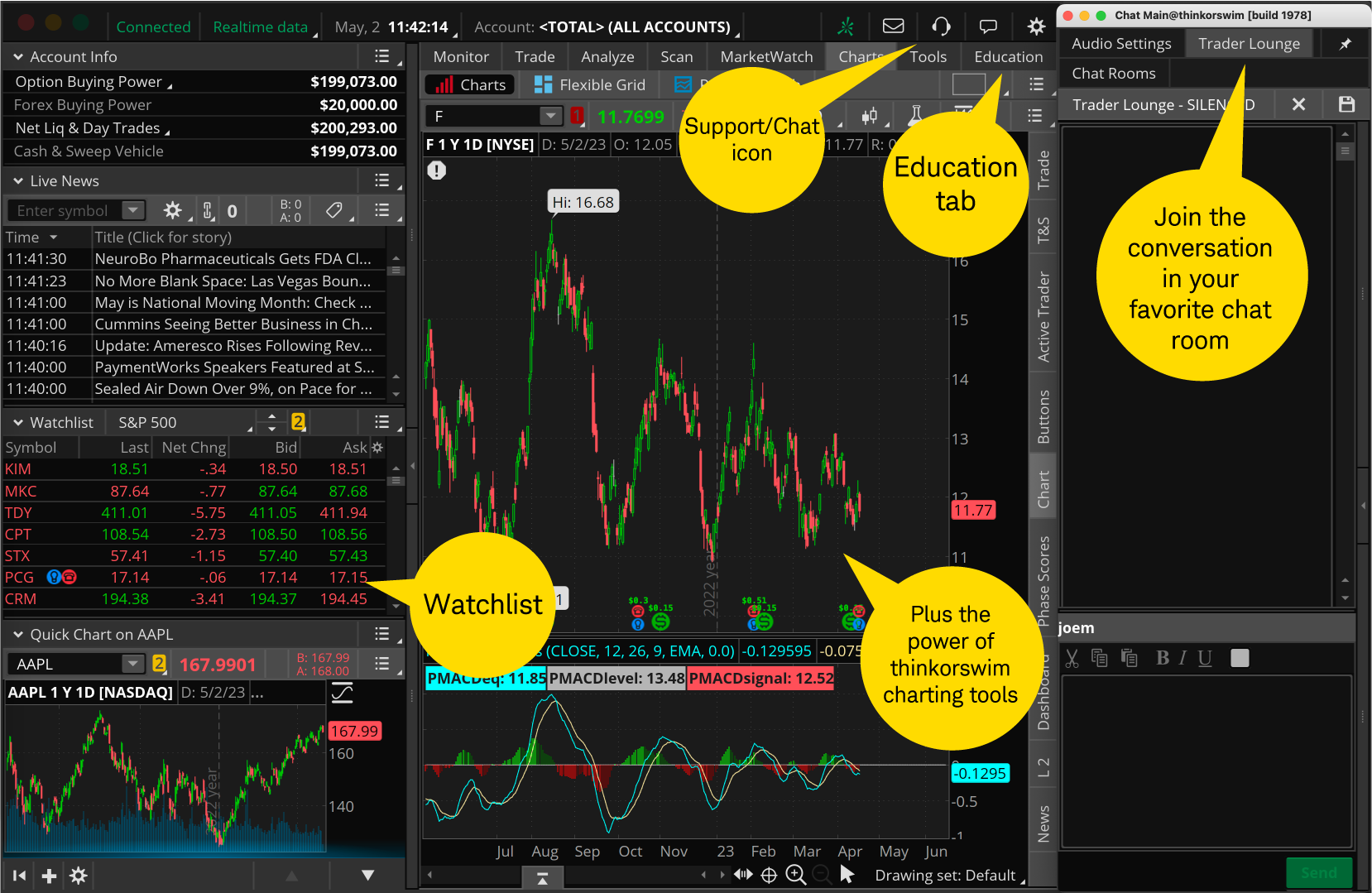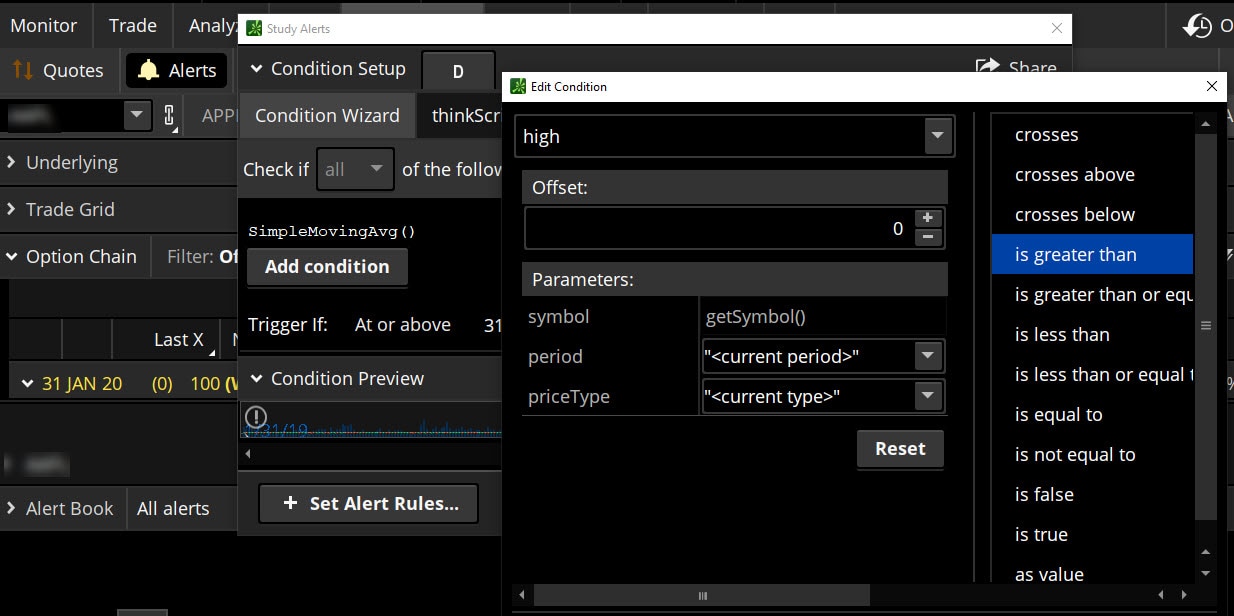
The success of every trade is defined by entry and exit points, as well as what happens in between. Understanding the full trade life cycle from start to finish, plus the mechanics and thought processes that accompany each phase, may help investors more fully pursue their trading and investing goals.
The pre-trade process
The first step in trading is to define the reason for the trade. A trader should have a thorough understanding of why they're making the trade, and in general, objectivity is better than subjectivity. Some traders believe that subjectivity can invite fear, greed and other factors that can lead to bad decision-making.
Consider the objective of the trade. What will the trade accomplish? Is the trade related to an earnings report or a change in direction for a stock price? It could be important for a trade to align with a trader's general portfolio strategy and goals.
The thinkorswim® platform offers a variety of technical analysis1 and fundamental analysis2 tools designed to review different aspects of assets and use that information to define a trading objective. Additional information tools include live news feeds, custom watchlists, and access to a myriad of education resources.
Sample setup on thinkorswim

Source: thinkorswim platform
A trade objective might be pulled from several sources, such as a bullish technical signal plus a strong earnings release bolstered by a news item. Three strong signals might inform a reasoned objective, as opposed to relying on a gut feeling.
An objective trade entry strategy—as opposed to a subjective strategy—can help eliminate the elements that may lead to bad decision-making.
Navigating the holding period
The time between the entry and exit on a trade is sometimes called the holding period. Here are some ideas for managing emotions during the holding period.
Don't look too often
New traders can get caught up in over-monitoring their positions. Veteran traders often understand that reviewing the position depends on the situation. A short-term stock trade or an options contract close to expiration might require a little extra attention. On the other hand, a dividend-paying stock meant for long-term holding could potentially need less regular monitoring.
Tracking the trades
The thinkorswim platform can make it simpler to track trades. Under the MarketWatch tab, select Alerts and enter a ticker symbol. The Alerts function monitors criteria like price or volatility levels, technical signals like crossovers, or fundamental triggers like dividend or earnings information. Alerts can be sent by email or text, and they can be viewed while you're logged in to the platform.
Setting up alerts

Source: thinkorswim platform
Additionally, it's possible to set up orders to be filled when a trade hits certain selected targets. Many traders use conditional orders, such as OCO (one-cancels-other) or bracket orders, to help them implement their strategies without constant monitoring.
Monitor as needed
Although longer-term trades generally require less time spent on trade management than shorter-term trades, some monitoring is warranted. For example, with a longer-term trade based on a fundamental signal, any significant change in the fundamentals could be reason to close the trade. In technical analysis, if a trend breaks down, it might be time to exit, regardless of the trade's value. Review the reasons for the trade. If the reasons no longer apply, even if the trade hasn't hit a profit or loss target, it may be time to reassess holding the trade in your portfolio.
Some traders also look at a trade's opportunity cost, meaning they consider not just the funds allocated to a trade but also the funds' value relative to other potential investments or uses. Opportunity cost can also include the time spent watching trades. If constant monitoring keeps a trader from accomplishing other goals, it might be time to consider moving on.
Making adjustments
Sometimes it takes days or weeks for a strategy to play out. But the next decision in the trade life cycle isn’t limited to "sell or hold." It's also possible to make adjustments to a trade. For example, a trader might sell a covered call3 to potentially generate income from a long stock position or purchase a protective put4 to help limit downside risk.
When trading options or adding options positions to an existing stock position, there are many strategies, strikes, and expiration dates to choose from. It's important to note that options trading can carry significant risk and choosing among strikes and expiration dates involves balancing risks and potential returns.
Exiting the trade
Exiting a trade requires careful thought and attention to your objectives. Here are two considerations when deciding among trade exit strategies.
Deciding to close the trade
The original trade objectives used as an example earlier included a bullish technical signal, plus a strong earnings release that is bolstered by a news item.
There are some potential considerations when analyzing whether it's time to close a trade. Consider looking at news events, as well as using technical analysis and fundamental analysis. If one or more of the reasons a trader entered a trade no longer apply, that might be reason enough to close the trade. Perhaps the next earnings report didn't follow through on the previously reported strength, or maybe technical analysis identified a resistance5 level or other potentially bearish signal.
If the reason for the trade no longer exists, it might be time to liquidate, regardless of profit or loss. No one likes losing trades, but closing a losing trade can free up capital for the next trade.
Another reason could be key numbers related to your objective. Some traders set percentage gain and loss objectives, such as a 5% gain versus a 2% loss. Others set exit points in dollar terms. For a $150 stock, that would translate to a gain of $7.50 per share versus a loss of $3 per share.
Closing your trade
The thinkorswim platform can be configured to provide alerts when an exit point nears. There are different choices for exiting the trade, including a basic order type like a limit order6.
It's also possible to enter this trade as good 'til canceled (GTC). In this case, the order is good either until it's filled (for up to six months) or until it's canceled. Creating a GTC order versus a regular day order means there's no need to enter the trade each day until it's filled.
Another strategy is a sell stop order, which automatically executes when a position drops to a specified price point. It's important to note that entering a stop order does not guarantee execution at or near that price. Once activated, the order competes with other incoming market orders.
Limit orders and stop orders are strategies to manage trades if a trader doesn't watch the market on a continual basis.
Regardless of how you choose to exit a position, some traders recommend choosing objectives and exiting the trade when it no longer serves those objectives. Following a plan, from start to finish, can be an important part of your trading or investing strategy.
1 Examines historical trading data such as price and volume data to identify previous chart patterns with the hope of anticipating stock price movements. Some technical analysis tools include moving averages, oscillators, and trendlines. Schwab does not recommend technical analysis as a sole means of investment research.
2 Fundamental analysis attempts to derive the value of a stock or other security by analyzing a company's financial statements, management, competitive environment, overall economic conditions, and other factors. Some popular fundamental indicators include the price-to-earnings (P/E) ratio, earnings per share, and price/earnings-to-growth ratio.
3 A limited-return strategy constructed of a long stock and a short call. Ideally, you want the stock to finish at or below the call strike at expiration. If the stock price settles above the strike price, in almost all cases you'd have your stock called away at the short call strike. You'd keep your original credit from the sale of the call as well as any gain in the stock up to the strike. Breakeven on the trade is the stock price you paid minus the credit from the call and transaction costs.
4 An options strategy intended to guard against the loss of unrealized gains. The put option costs money, which reduces the investor's potential gains from owning the security, but it also reduces the risk of losing money if the underlying security declines in value.
5 In technical analysis, resistance is a price level at which upward movement may be restrained by accumulated supply at or around that price level.
6 A limit order indicates the highest price you're willing to pay for a security, or the lowest price you're willing to accept to sell a security. Your order will be executed at your designated price or better. This helps protect your order from sudden volatility, but it also means you'll only buy or sell the security if it reaches the price you're seeking.
Options carry a high level of risk and are not suitable for all investors. Certain requirements must be met to trade options through Schwab. Please read the options disclosure document titled "Characteristics and Risks of Standardized Options" before considering any options transaction. Supporting documentation for any claims or statistical information is available upon request.
With long options, investors may lose 100% of funds invested. Hedging and protective strategies generally involve additional costs and do not assure a profit or guarantee against loss. All stock and options symbols and market data shown are for illustrative purposes only and are not a recommendation, offer to sell, or a solicitation of an offer to buy any security.
Covered calls provide downside protection only to the extent of the premium received and limit upside potential to the strike price plus premium received.
The information provided here is for general informational purposes only and should not be considered an individualized recommendation or personalized investment advice. The investment strategies mentioned here may not be suitable for everyone. Each investor needs to review an investment strategy for his or her own particular situation before making any investment decision.
Examples provided are for illustrative purposes only and not intended to be reflective of results you can expect to achieve.
Past performance is no guarantee of future results.
Investing involves risks, including loss of principal.
0723-3P64

